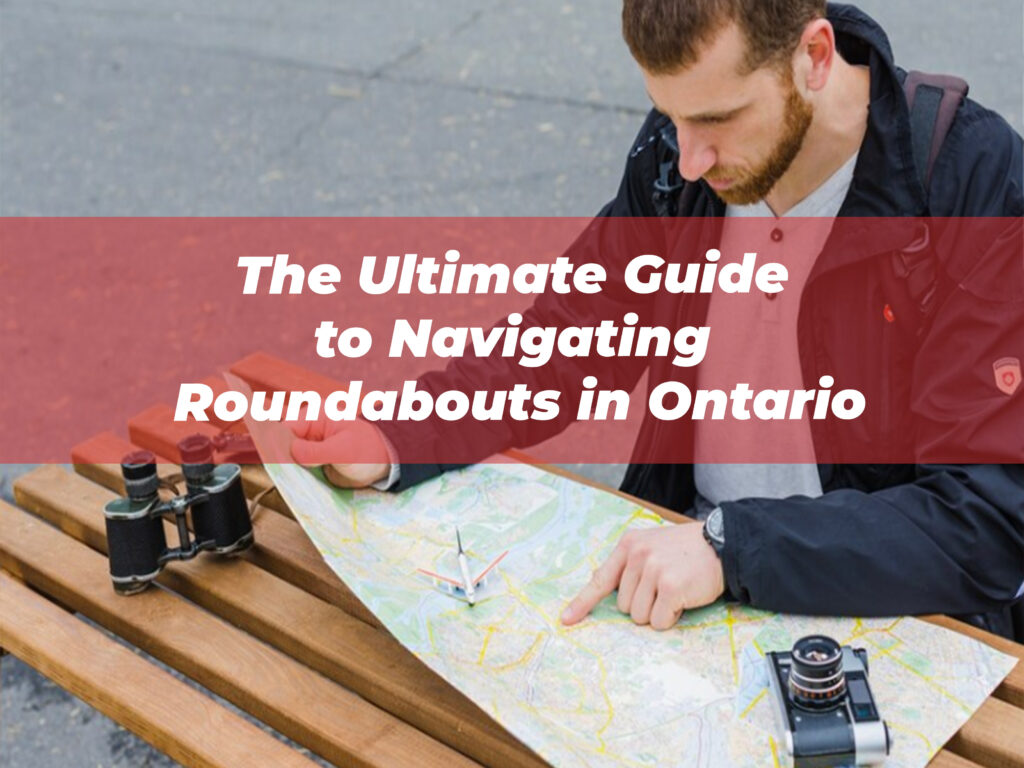Guide to Navigating Roundabouts are becoming increasingly common on Ontario’s roads as municipalities prioritize safer and more efficient traffic flow. But for many drivers, these circular intersections can be both confusing and intimidating. Whether you’re a seasoned Ontario driver or new to the province, understanding how to properly approach, enter, and exit a roundabout is essential.
This ultimate guide will walk you through everything you need to know about roundabouts in Ontario. From the rules and common mistakes to the benefits they bring and practical tips for safe navigation, we’ve got you covered.
What Is a Roundabout and Why Are They Used?
A roundabout is a circular Guide to Navigating Roundabouts where traffic moves counterclockwise around a central island. Drivers entering the roundabout yield to traffic already inside. Unlike traditional intersections with stop signs or traffic lights, roundabouts keep traffic flowing smoothly, minimizing congestion and reducing the risk of high-speed collisions.
Ontario municipalities are installing more roundabouts because they offer a safer and more efficient alternative to traditional intersections. Studies show they can reduce severe crashes by up to 80% and improve overall traffic flow. They’re also environmentally friendly, as vehicles spend less time idling compared to intersections with traffic signals.
Understanding how to properly use roundabouts can help you stay Guide to Navigating Roundabouts and take full advantage of these innovative intersections.
Understanding Roundabout Rules in Ontario
Navigating a roundabout correctly starts with knowing and following the basic rules. Here’s what you need to keep in mind:
1. Yield to Traffic Within the Roundabout
One of the fundamental rules of roundabouts is yielding to vehicles already inside. The traffic in the circle has the right of way, so entering vehicles must wait for a gap before merging.
2. Yield to Pedestrians and Cyclists
Always check for pedestrians and Guide to Navigating Roundabouts at the crosswalks around the entry and exit points of the roundabout. They have the right of way.
3. Signal When Exiting
Proper signaling is crucial in a roundabout. Use your right turn signal before exiting to clearly indicate your intentions to other drivers.
4. Stay in Your Lane
Roundabouts often have lane markings guiding you to your Guide to Navigating Roundabouts exit. Choose your lane early and stay in it until you’re ready to exit.
5. Follow the Speed Limit
Roundabouts are designed for low-speed travel. Most have speed limits of 30-50 km/h. Reducing your speed helps you stay in control and improves reaction time.
Types of Roundabouts in Ontario
Not all roundabouts are the same. Depending on the Guide to Navigating Roundabouts and traffic conditions, you might encounter different types of roundabouts in Ontario:
- Single-Lane Roundabouts: These are the simplest type. All traffic flows in one lane, making navigation easy and straightforward.
- Multi-Lane Roundabouts: These are larger and have two or more lanes. They require extra attention to signage and lane markings to ensure proper navigation.
- Mini-Roundabouts: Found mostly in residential areas, these are compact versions of regular roundabouts with smaller central islands.
- Truck Aprons: These are the slightly raised areas around the central island in larger roundabouts. They allow large vehicles to maneuver while keeping smaller Driving Instructor out.
Each type of roundabout requires slightly different navigation Guide to Navigating Roundabouts, but the basic principles remain the same.

Benefits of Roundabouts
The growing popularity of roundabouts in Ontario is no accident. They bring numerous advantages over traditional intersections:
1. Improved Safety
Roundabouts eliminate the possibility of Guide to Navigating Roundabouts T-bone and head-on collisions. The low-speed, circular traffic flow reduces the severity of accidents.
2. Better Traffic Flow
Unlike traffic lights, which create stop-and-go conditions, roundabouts allow vehicles to keep moving. This reduces congestion, especially during off-peak hours.
3. Environmental Benefits
Less idling means fewer emissions. Roundabouts contribute to cleaner air and improved fuel efficiency for drivers.
4. Cost Savings
While the initial cost of building a roundabout is high, they save money over the long term by reducing the need for traffic lights and associated maintenance.
5. Aesthetic Appeal
Well-designed roundabouts can be landscaped, Guide to Navigating Roundabouts to the roadway and even serving as a community centerpiece.
Common Mistakes to Avoid in Roundabouts
Improper use of roundabouts can lead to confusion, bottlenecks, and even accidents. Here are some common mistakes drivers make and how to avoid them:
1. Entering Without Yielding
Failing to yield to traffic already in the roundabout is a major cause of collisions. Always wait for a clear gap before entering.
2. Changing Lanes Within the Roundabout
Switching lanes inside a roundabout is unsafe. Choose your lane well in advance and stick to it until you Guide to Navigating Roundabouts.
3. Not Signaling When Exiting
Signaling your exit helps other drivers anticipate your movement and reduces the chances of close calls.
4. Stopping Inside the Roundabout
Once inside the roundabout, stopping can disrupt the Guide to Navigating Roundabouts and lead to accidents. Keep moving unless absolutely necessary.
5. Ignoring Pedestrians and Cyclists
Always scan for pedestrians and cyclists at crosswalks. Courtesy and caution go a long way in ensuring everyone’s safety.
6. Driving Too Fast
Speeding through a roundabout reduces your ability to react in time and increases the risk of losing control. Always follow the speed limit and slow down in poor weather conditions.
Tips for Safely Navigating Roundabouts
To help you confidently approach and travel through roundabouts, follow these practical tips:
Before Entering the Roundabout
- Identify Your Exit: Look for road signs Guide to Navigating Roundabouts the exits and choose the one that aligns with your destination.
- Select the Correct Lane: Follow road markings and signs to position yourself in the appropriate lane before entering.
- Slow Down: Reduce your speed as you approach the roundabout. This gives you better control and enough time to assess traffic.
- Yield to Traffic and Pedestrians: Stop if needed and wait for a safe opportunity to enter.
Inside the Roundabout
- Maintain a Low Speed: Stay within the posted speed limit and monitor your surroundings.
- Stay in Your Lane: Avoid sharp turns or lane changes. Stick to your chosen lane.
- Be Aware of Large Vehicles: Trucks may need extra space, so give them room.
Exiting the Roundabout
- Signal Early: Use your right turn signal just before your exit to alert other drivers.
- Check Blind Spots: Look over your shoulder to ensure no cyclists or vehicles are in your blind Guide to Navigating Roundabouts.
- Exit Safely: Follow the lane markings and move smoothly into your desired direction.
Additional Tips
- Practice on simple single-lane roundabouts before tackling complex multi-lane ones.
- Avoid distractions like mobile phones while navigating a roundabout.
- Keep a safe distance from the vehicle ahead to allow for sudden stops or changes.
How to Teach Roundabout Navigation to New Drivers
If you’re a parent or instructor teaching someone how to drive in Ontario, make sure to spend time practicing roundabouts. Here’s how you can help new drivers build confidence:
- Start with Theory: Explain the rules of Guide to Navigating Roundabouts, including yielding, signaling, and lane discipline.
- Use Visual Aids: Diagrams and videos can help illustrate proper roundabout navigation.
- Practice in Low-Traffic Areas: Begin with single-lane roundabouts in residential or quiet areas.
- Build Gradually: Move on to busier or multi-lane roundabouts as confidence grows.
- Provide Feedback: Offer constructive tips after each attempt to help them improve.
Final Thoughts on Mastering Roundabouts in Ontario
Roundabouts may seem challenging at first, but with a little practice and a clear understanding of the rules, they can be navigated safely and confidently. By yielding to traffic, signaling appropriately, and staying in your lane, you’ll contribute to smoother traffic flow and a safer driving experience for everyone.
Remember, roundabouts are designed to make roadways safer and more efficient. As they become more common in Ontario, it’s essential for all drivers to familiarize themselves with proper navigation techniques.
Now it’s your turn! Share this guide with family and Guide to Navigating Roundabouts to spread awareness about safe roundabout practices. And don’t forget to keep honing your driving skills to become a confident and responsible driver in every situation.










